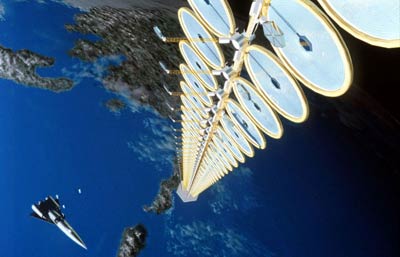Space solar power: opposition and obstaclesby Taylor Dinerman
|
| The choices are not between a bad “nanny state” solution and a good capitalist free market one, but between a future with some slow and messy progress towards alternative energy sources and one which looks a lot like our present predicament with less resources and less freedom for everyone. |
The late French historian Francois Furet once made the point that “Of all the passions of modern democracy… the oldest, the most constant, and the most powerful is the hatred of the bourgeoisie.” Middle-class capitalist democracy is the most successful form of government so far invented by human beings. Reliable, relatively low-cost energy is critical to a democratic capitalist economy. It is no accident, as our old Soviet friends used to say, that the US consumes roughly 25% or the world’s energy and produces about 25% of the world’s GDP. Energy is naturally at the heart of any nation’s grand strategy. Foes of middle-class capitalist democracy see energy as being the system’s Achilles heal.
There are, of course, other objections from libertarians to alternative energy sources. Most of these revolve around the way the government subsidizes or mandates things like ethanol content or “renewable” energy. While these objections are legitimate and are not aimed at inflicting harm on the US or other Western nations, they are beside the point. The choices are not between a bad “nanny state” solution and a good capitalist free market one, but between a future with some slow and messy progress towards alternative energy sources and one which looks a lot like our present predicament with less resources and less freedom for everyone.
We are at war, and energy is one of the central fronts. The less energy the West as a whole buys from its foes, the closer it comes to winning. In an ideal world the market would pick and choose energy winners in the same way that consumers can make or break any normal product or service based on quality and price. Unfortunately energy, like water, is one of those things that does not lend itself easily to a pure free market solution.
Large-scale use of energy from space in the form of solar power beamed down to Earth is going to be an important alternative way for the US and its allies to generate the electricity needed to meet the needed of an expanding world economy. As long as it’s a pie-in-the-sky proposition, proponents of space solar power will be confined to a small club of space enthusiasts. Once it becomes an economically viable method of supplying, say, five or ten percent of the country’s electricity consumption, we can expect that the same anathemas that have been called down on nuclear power to be aimed at space solar power.
In reality, the main obstacles to space solar power are technological and economic. There seem to be few real scientific problems, but of course there will be a constant need for studies to show how safe, or comparatively safe, these systems are. Low-cost access to space is the first and hardest hurdle to overcome. While the US government’s investment in RLVs has been radically reduced over the last few years, outsiders such as Burt Rutan’s Spaceship Company, Jeff Bezos and his Blue Origin team, and Elon Musk’s SpaceX are building rockets that could eventually reduce the cost of getting into low Earth orbit to something like the few hundred dollars a kilogram that is generally considered the “tipping point” for large-scale space commercialization.
One important point is that if NASA’s heavy-lift Ares 5 launcher is built, it would be an ideal tool with which to place the heavy elements of a solar power satellite into orbit. The space agency should welcome the opportunity to turn what would otherwise be a highly specialized and rarely used heavy lifter into a multi-purpose space transportation vehicle that could actually serve a commercial purpose.
The other really big problem is that no one has ever even tried to build anything the size of a solar power satellite in space. Russia’s Mir space station and the ISS are the only examples we have of anything that even approaches the size and complexity of an SPS. The difficulties that both these projects have encountered bodes nothing but ill for a project that tried to use modern-day technology. Lighter structures made from new materials might help, as would new methods of power and thermal management.
| In reality, the main obstacles to space solar power are technological and economic. |
One technology that might radically reduce the weight requirements for these systems is the technique pioneered at the University of Notre Dame where single-walled carbon nanotubes are added to a film made of titanium-dioxide nanoparticles, doubling the efficiency of converting ultraviolet light into electrons. Any solar cell technology that could reach conversion factors of over 50% or even higher would reduce the size and weight of an SPS and thus make it easier and cheaper to build and launch.
We all know that things never stand still, and within the next ten or twenty years there may be breakthroughs that will change the situation. RLVs using structures made with nanotubes could radically reduce the cost of getting payloads into space. The same technology could also be used to build the SPSs themselves. Other, even more exotic space access solutions may exist, such as laser-powered launch vehicles or electromagnetic launchers.
The demand for new sources of electricity is growing fast. Space solar power is one realistic alternative that does not require the use of coal or uranium. The private sector is not now ready to invest the very large sums needed to build a viable infrastructure, but that will change if the technology can be demonstrated.
